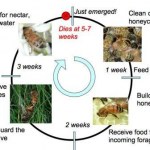Whenever I read a paper from Karl-Arne Stokkan's lab, and I have read every one of them, no matter how dense the scientese language I always start imagining them running around the cold, dark Arctic, wielding enormous butterfly nets, looking for and catching reindeer (or ptarmigans, whichever animal the paper is about) to do their research.
If I was not so averse to cold, I'd think this would be the best career in science ever!
It is no surprise that their latest paper - A Circadian Clock Is Not Required in an Arctic Mammal (press release) - was widely covered by the media, both…
Clock Zoo
If you ever glanced at the circadian literature, you have probably encountered the statement that "circadian rhythms are ubiquitous in living systems". In all of my formal and informal writing I qualified that statement somewhat, stating something along the lines of "most organisms living on or near the Earth's surface have circadian rhythms". Why?
In the earliest days of chronobiology, it made sense to do most of the work on readily available organisms: plants, insects, mammals and birds. During the 20th century, thousands of species of animals, fungi, protists and plants - all living on…
Most people are aware that social insects, like honeybees, have three "sexes": queens, drones and workers.
Drones are males. Their only job is to fly out and mate with the queen after which they drop dead.
Female larvae fed 'royal jelly' emerge as queens. After mating, the young queen takes a bunch of workers with her and sets up a new colony. She lives much longer than other bees and spends her life laying gazillions of eggs continuously around the clock, while being fed by workers.
Female larvae not fed the 'royal jelly' emerge as workers.
Workers perform a variety of jobs in the hive.…
Long-time readers of this blog remember that, some years ago, I did a nifty little study on the Influence of Light Cycle on Dominance Status and Aggression in Crayfish. The department has moved to a new building, the crayfish lab is gone, I am out of science, so chances of following up on that study are very low. And what we did was too small even for a Least Publishable Unit, so, in order to have the scientific community aware of our results, I posted them (with agreement from my co-authors) on my blog. So, although I myself am unlikely to continue studying the relationship between the…
As I announced this morning, there will be several guest posts here over the next several weeks. The first one, by Barn Owl of the lovely Guadalupe Storm-Petrel blog, is likely to appeal to a lot of my readers as it combines several of my own interests:
====================
In this guest-post for A Blog Around the Clock, I'll combine three things that Coturnix especially likes: horses, circadian biology, and an Open Access research paper. For the equestrian, there are two main seasonal issues, controlled primarily by photoperiod, or day length, which must be considered, especially if one…
Glow worms glimmer on cue:
University of Queensland researcher and lecturer Dr David Merritt has discovered that Tasmanian cave glow-worms are energy conservationists: they switch their lights off at night-time.
The discovery was made during a partially funded UQ Firstlink study, which revealed that the glow-worm's prey-luring light output is governed by circadian rhythms, regardless of ambient light levels.
The study aimed to investigate the physiology and behaviours of cave dwelling glow-worms, which are actually the immature or larval stage of a mosquito-like fly found in Queensland, New…
Believe it or not, this appears to have something to do with their circadian rhythms!
Back in the 1960s and early 1970s, there was quite a lot of research published on the circadian rhythms in earthworms, mostly by Miriam Bennett. As far as I can tell, nobody's followed up on that work since. I know, from a trusted source, that earthworms will not run in running-wheels, believe it or not! The wheels were modified to contain a groove down the middle (so that the worm can go only in one direction and not off the wheel), the groove was covered with filter paper (to prevent the worm from…
Fifth in the five-part series on clocks in bacteria, covering more politics than biology (from May 17, 2006):
In the previous posts in this series, I covered the circadian clocks in Synechococcus, potential circadian clocks in a couple of other bacteria, and the presence of clock genes (thus potentially clocks) in a number of other bacteria. But what happened to the microbiological workhorse, the Escherichia coli? Does it have a clock? Hasn't anyone checked?
Believe it or not, this question is colored by politics. But I have to give you a little background first. Latter half of the 19th…
Fourth in the five-part series on clocks in bacteria (from April 30, 2006):
For decades, it was thought that prokaryotes did not have circadian clocks. Then, a clock was discovered in a unicellular cyanobacterium, Synechococcus (later also in Synechocystis [1] and Trichodesmium [2]) which quickly became an important model in the study of circadian rhythms in general. Still, it was thought, for ten years or so, that no other prokaryotes had a circadian clock. Recently, the clock genes were found in filamentous (chain-forming) cyanobacteria, as well as a whole host of other bacteria and…
The third installment in the five-part series on clocks in bacteria (from April 19, 2006):
As you probably know, my specialty are birds, so writing this series on clocks in microorganisms was quite an eye-opener for me and I have learned a lot. The previous two posts cover the clocks in the cyanobacterium Synechococcus elongatus, the first bacterium in which circadian rhythms were discovered and, thus, the species most studied to date.
The work in Synechococcus has uncovered a cluster of three genes - kaiA, kaiB and kaiC - that are essential for circadian rhytmicity in this species. kaiA…
Second post in a series of five (from April 05, 2006):
In the previous two posts, here and here, I have mentioned how the discovery of circadian clocks in Cyanobacteria changed the way we think about the origin and evolution of circadian clocks. Quite soon after the initial discovery, the team from Carl Johnson's laboratory published two papers [1,2] describing a more direct test of adaptive function of circadian clocks in the Synechococcus elongatus.
Wild-type and various clock-mutants in Synechoccocus, when raised in isolation in light-dark cycles, have comparable reproductive rates.…
First in a series of five posts on clocks in bacteria (from March 08, 2006)...
As I stated in the introductory post on this topic, it was thought for a long time that prokaryotes were incapable of generating circadian rhythms. When it was discovered, in 1994 [1], that one group of prokaryotes, the cyanobacteria, possess a circadian clock, the news was greeted with great excitement. This was the first definitive demonstration of a circadian clock in a bacterium (I intend to revisit the E.coli saga in a later post).
All three hypotheses for the origin of the circadian clock suppose that it…
The first in a series of posts on circadian clocks in microorganisms (from February 23, 2006)...
Many papers in chronobiology state that circadian clocks are ubiqutous. That has been a mantra since at least 1960. This suggests that most or all organisms on Earth possess biological clocks.
In the pioneering days of chronobiology, it was a common practice to go out in the woods and collect as many species as possible and document the existence of circadian rhythms. Technical limitations certainly influenced what kinds of organisms were usually tested.
Rhythms of locomotor activity are the…
The origin and early evolution of circadian clocks are far from clear. It is now widely believed that the clocks in cyanobacteria and the clocks in Eukarya evolved independently from each other. It is also possible that some Archaea possess clock - at least they have clock genes, thought to have arived there by lateral transfer from cyanobacteria.[continued under the fold]
It is not well known, though, if the clocks in major groups of Eukarya - Protista, Plants, Fungi and Animals - originated independently or out of a common ancestral clock. On one hand, the internal logic of the clock…
Much of the biological research is done in a handful of model organisms. Important studies in organisms that can help us better understand the evolutionary relationships on a large scale tend to be hidden far away from the limelight of press releases and big journals. Here's one example (March 30, 2006):
--------------------------------------------------
Short answer: nobody knows. Nobody has looked yet. Most of the research in biology is, quite rightfully, performed in just a handful of standard models. A sponge is not a standard animal lab model.
Should one expect sponges to have…
We have recently covered interesting reproductive adaptations in mammals, birds, insects, flatworms, plants and protists. For the time being (until I lose inspiration) I'll try to leave cephalopod sex to the experts and the pretty flower sex to the chimp crew.
In the meantime, I want to cover another Kingdom - the mysterious world of Fungi. And what follows is not just a cute example of a wonderfully evolved reproductive strategy, and not just a way to couple together my two passions - clocks and sex - but also (at the very end), an opportunity to post some of my own hypotheses online.…
It has been almost three years since I promised to write a post detailing the photoperiodic response in mammals. (Birds are more complicated).
Now Shelley gives a good example - the snowshoe hare which changes color annually: it is dark in summer and white in winter. It is pretty easy to remember - it's all the Mel-something molecules involved. So, here is a very simplified, but essentially correct description of how this happens:
Light is detected by the photo-pigment melanopsin in the retinal ganglion cells of the eye. The cells send a signal to the clock (in the suprachiasmatic nucleus…
I had no time to read this in detail and write a really decent overview here, perhaps I will do it later, but for now, here are the links and key excerpts from a pair of exciting new papers in PLoS Biology and PLoS ONE, which describe the patterns of expression of a second type of cryptochrome gene in Monarch butterflies.
This cryptochrome (Cry) is more similar to the vertebrate Cry than the insect Cry, also present in this butterfly. The temporal and spatial patterns of expression of the two types of Cry suggest that they may be involved in the transfer of time-information from the…
Last week I had lunch with a good old friend of mine, Jim Green. He got his degree in Zoology, then a law degree (patent law) and is now coming back for yet another degree in biological and chemical engineering. He did his research on snakes, so we reminisced and laughed about the time several years ago (that was before Kevin joined the lab, which is why I was recruited for this study in the first place) when we were taking blood samples from copperheads.
What we wanted to do is see if snakes have melatonin and if so, if it shows a diurnal rhythm in concentration like it does in other…
Much of the biological research is done in a handful of model organisms. Important studies in organisms that can help us better understand the evolutionary relationships on a large scale tend to be hidden far away from the limelight of press releases and big journals. Here's one example (March 30, 2006):
--------------------------------------------------
Short answer: nobody knows. Nobody has looked yet. Most of the research in biology is, quite rightfully, performed in just a handful of standard models. A sponge is not a standard animal lab model.
Should one expect sponges to have…

